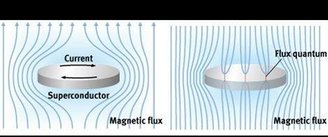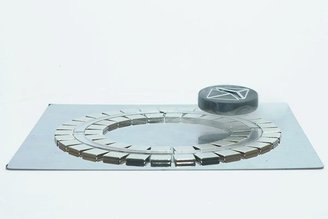Since ancient times, one of the most fantastic ideas to emerge from the human imagination is the idea of rising from the ground. Although we still don’t have hoverboards floating around like in science fiction, humanity has already discovered a real and (almost) good phenomenon: quantum levitation!
In everyday life, if you apply voltage to any system of charged particles, this causes them to move in an orderly flow, creating an electric current through the material. However, in these cases, the internal resistance of the material (usually metallic) through which the current passes will restrict and prevent this movement.
However, under certain low temperature conditions in certain specific materials the resistance can drop very close to zero, creating a “lossless” medium through which electricity flows. This medium is called superconductor..
If we take advantage of the properties of some superconducting materials containing impurities, these materials can be placed on suitably configured magnets and, as a result, they will remain suspended there indefinitely.
The key to quantum levitation lies in the Meissner effect, discovered by German physicist Walther Meissner in 1933, which occurs when a material enters a superconducting state below a certain critical temperature value.
This effect causes the superconductor to completely expel magnetic fields from its interior, causing the field to bypass the surface of the material. When a magnet is placed near a superconductor, the magnet’s magnetic field cannot penetrate the material, resulting in levitation..
However, in some types of superconductors, especially II. In type superconductors (consisting of metallic alloys and other compounds) the magnetic field is not completely expelled. Instead, it creates magnetic vortices that penetrate certain areas of the superconductor.
The superconductor is then “locked” in the magnetic field, providing extraordinary stability. This is the phenomenon of quantum locking, which allows the object to rise and remain fixed in a fixed position regardless of whether it is moved up, down or sideways.

If we make a magnetic path for this type of superconductor and set it in motion, it will stay in motion forever. If we did this by eliminating all air resistance in a vacuum chamber, we would have a device that could continue its infinite motion without significant loss of energy.
This would be the realization of an old dream of scientists: the creation of a perpetual motion machine.
The phenomenon of quantum levitation has the potential to profoundly transform modern technology, especially in the transportation sector, where it will have one of the most promising applications.

These will be accomplished through floating trains on magnetic, frictionless rails that can reach very high speeds with far greater energy efficiency than current transportation methods. This technology already exists in experimental form, such as magnetic levitation trains (maglev), which use similar principles although superconductors are not used.
Moreover, quantum levitation could have various applications in creating frictionless motors, energy storage, and even quantum computing. Superconductivity could revolutionize data and information transfer by enabling perfect conduction of electricity..

Although quantum levitation is an impressive phenomenon, it still faces some practical challenges; the biggest of these is the need for extremely low temperatures for superconductivity to occur. Keeping materials at temperatures near absolute zero requires advanced and expensive cooling equipment, limiting their large-scale applications.
But with the constant advancement of materials science, researchers are constantly looking for superconductors that operate at higher temperatures. could make quantum levitation more feasible in everyday applications in the near future.
Source: Tec Mundo
I’m Blaine Morgan, an experienced journalist and writer with over 8 years of experience in the tech industry. My expertise lies in writing about technology news and trends, covering everything from cutting-edge gadgets to emerging software developments. I’ve written for several leading publications including Gadget Onus where I am an author.













